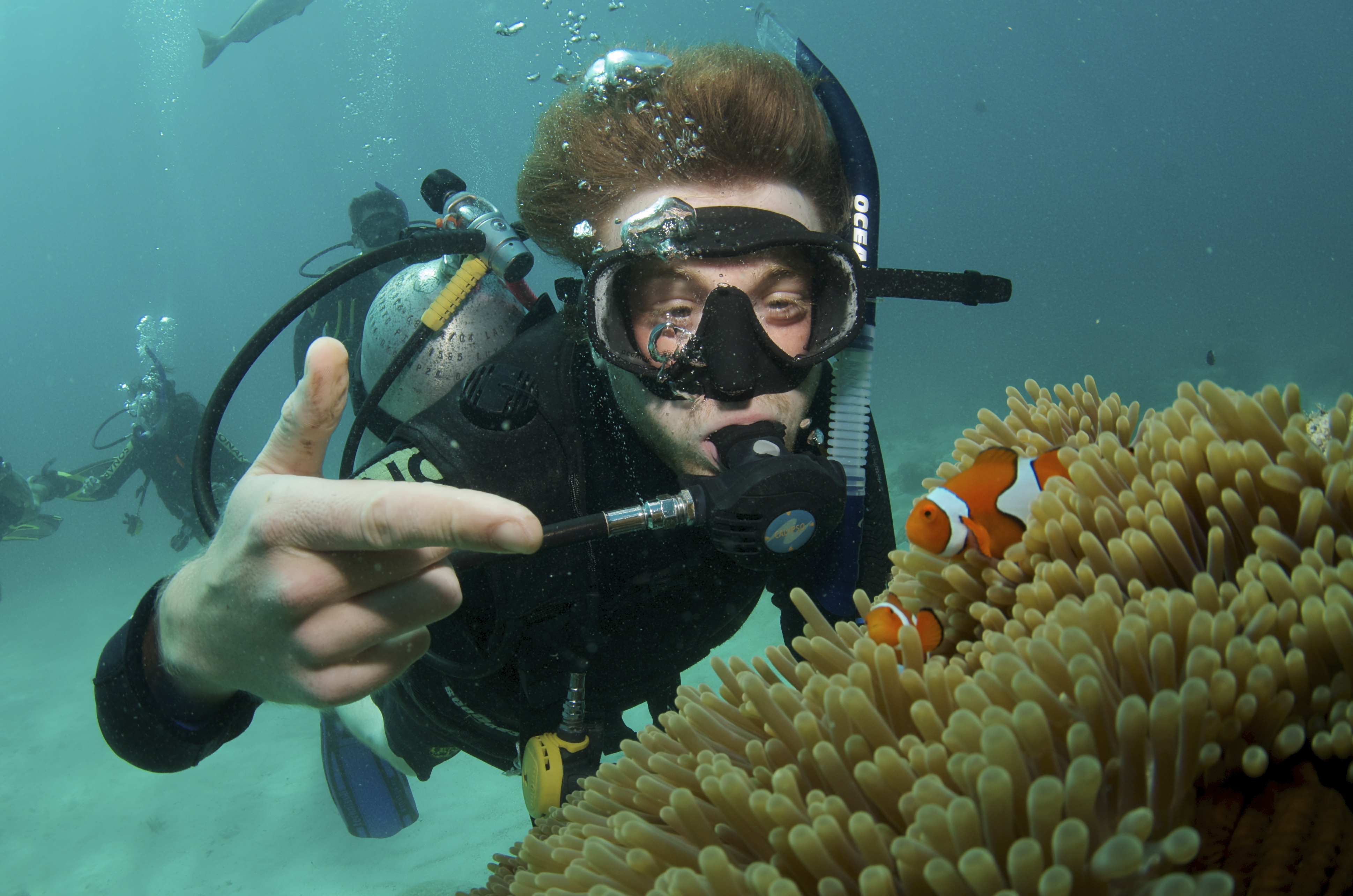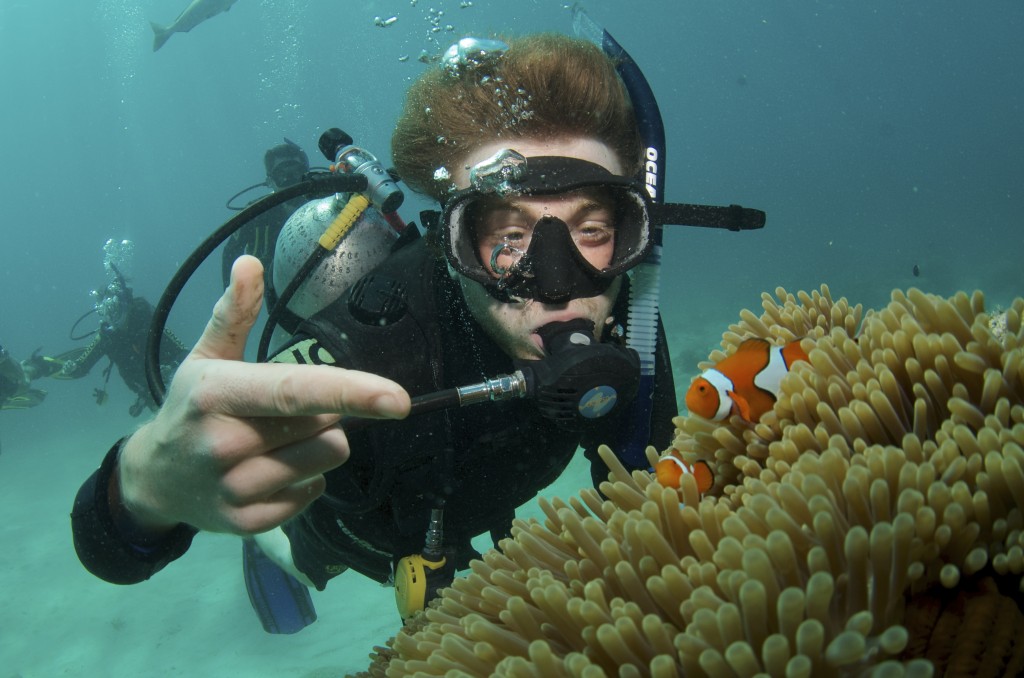
I saw it out of the corner of my right eye, and felt my heart bounce a beat. A long, silky body trailed behind its rounded gray head, bearing a mouth of razor sharp, menacing teeth. He glided through the water with ease, and to my relief didn’t even seem to be curious about our presence in his hunting grounds at all. I thought to myself, “Holy shit, I’m swimming with sharks!”
Just two days prior to my first shark encounter, I was sitting in a classroom at the Deep Sea Diver’s Den in Cairns, a city in Northern Queensland, Australia. I was on Easter holiday and had off from school, so I decided to spend that time attaining a license to scuba dive. And what better place to do that than on the illustrious Great Barrier Reef?
I went and signed myself up for a five-day Open Water Diver course, an entry-level course conducted by the Professional Association of Diving Instructors (PADI). My course instructor, a 27-year-old Londoner by the name of Ollie McGuiness, picked me up at my hostel at 7:30 a.m. in a big white van with the dive center’s name painted in black on the door. Ollie was an experienced diver with a number of certifications, and has been a diving instructor for more than five years. He has led dives in Belize, the Caribbean Sea and all throughout the Great Barrier Reef. We shook hands and exchanged names, I climbed into the van and we were off.
When I got to the dive center, I was introduced to my two classmates, 19-year-old Prema Shah from London, England and a 20-year-old third-year mechanical engineering major at Cornell University, Arturo Sullivan. Arturo, or Art, was also on Easter break from his university at the time. He is studying abroad in Brisbane at Queensland University, about an hour’s drive north from where I’m studying now on the Gold Coast. We became friends and later in the course, were each other’s “dive buddy.”
Although it was slightly reminiscent of being in a class lecture, I rather enjoyed our class time at the diving center. Apart from the cheesy PADI videos that had more than obviously been produced in the early 1980s, learning the skills and techniques used by scuba divers was really interesting. We learned what to do if you or your dive buddy’s air tanks are depleted while still underwater, and how to clear out your mask if it is flooded while underwater without having to return to the surface. We learned about nitrogen narcosis, a depth induced feeling of being intoxicated that occurs when diving around 30 meters below the surface and safety and practical skills that divers have discovered over time.
While half the day was spent in the classroom, the other half was spent underwater in the dive center’s indoor pool. In the pool, we practiced the skills we had seen in the instructional videos over and over again. Ollie was pretty adamant about having us repeat our skills, so that they would be drilled into our heads and exercised as if they were second nature in the off chance we came across any of the problems he was preparing us for. Although most of the situations he readied us for are normally easy to avoid, its better to be safe than shit out of luck.
On the morning of the third day, the big white van with the black letters on its side pulled up at 6:50 a.m. on the dot, and with it, an eager Ollie swinging aside its large sliding door and yelling for me to jump in. There was a greater sense of excitement resonating in our bones that morning, because we weren’t headed for the dive center. Instead, we were going to the largest spanning coral reef system that Earth has to offer, the home of tens of thousands of various marine life species. I was on my way to see firsthand one of the seven natural wonders of the world. I was finally going to dive the Great Barrier Reef.
We boarded the boat and traveled outland for around two hours to get to the reef. I don’t do too hot with seasickness, so I took some anti-nausea meds and dozed off. As we arrived at the first dive site, my classmates and Ollie hastily woke me up, telling me I had five minutes before it was dive time. I suited up as quickly as I could, checked that my equipment was all in order and then got in line at the side of the boat — ready to splash into the reef. When it was my turn to jump, I held my mask and breathing regulator tight with my left hand, while my right was secured to the weight belt that hung snugly around my waist. I took a wide step off the edge and fell into another world.
As my head submerged beneath the crisp, 70 degree water, I felt like I had just swam through a screen onto the set of Pixar’s “Finding Nemo.” It was so beautiful. I had a difficult time paying attention to my instructor who was having us run through our skills in an actual open water dive (as opposed to a confined water pool dive) which was part of our certification. All around us were amazing patches of coral, teeming with hundreds of fish and other fascinating marine life. I saw a clownfish swimming in and out of its anemone, a stingray with a sleek gray back with purple dots that looked to be painted and a sleek gray reef shark that glided effortlessly through the water.
My favorite fish was one that the dive instructors said they see often, and had even given him a name, Wally. Wally was about 5 feet in length, must’ve weighed well over 500 pounds and was the friendliest fish I think I’ll ever meet. He would swim over to us if we clinked rocks against our air tanks acting kind of like a dog. Ollie even managed to give Wally a kiss on his big, fat, blue lips.
Over the course of the next two nights and three days, we spent all of our time either diving or sleeping on a large boat with about 30 other divers. We got to dive five times a day, including once at night with waterproof flashlights! My classmates and I all passed our tests and obtained our Open Water certifications, a license that will allow me to explore parts of the world that necessitate the ability to breathe underwater in order to explore. Being a scuba diver has always been a dream of mine, and becoming one at the Great Barrier Reef was a pretty nice way to tick that goal off the bucket list.

